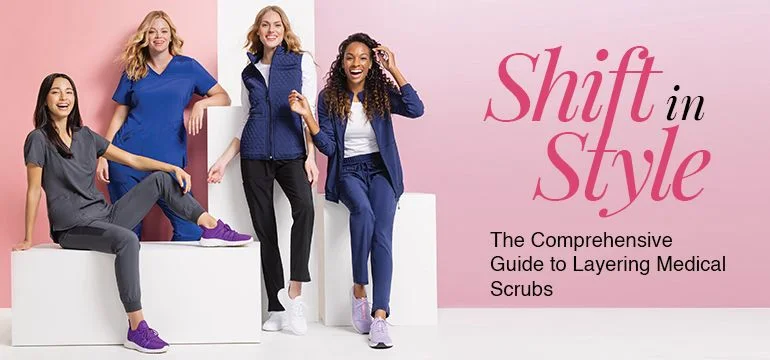
Within the medical facilities we usually see quite different temperatures compared to the weather outside. Sometimes the temperature inside the facility can be comfortable enough to wear regular medical scrubs. However, in the autumn and winter months medical facilities can feel extra chilly and without layering properly even a simple shift can feel much longer than it actually is. But in a work environment where we are assigned uniforms, how do we know what is appropriate accompaniment with our work clothes? What do we wear with our medical scrubs that would keep us warm, along with being comfortable and functional?
Here is a guide to help you layer your medical scrubs while still looking fabulously professional and getting your work done even on a long shift.
In order to work a long shift in a cold medical facility it is crucial to know how to dress in order to work well. Though the medical scrubs we wear are two piece sets, yet their material is light and does nothing against the cold temperatures. Thus it is important to know the clothes you can wear to layer up and be warm. The most common items of clothing we use to layer up are:
Opting to wear medical scrubs with long sleeves is a good way to be prepared for any kind of indoor temperature. You can roll the sleeves up or down depending how hot or cold it is. All you need to do is pair it with a tank top underneath for additional warmth and you are set for a long day of patient care.
All medical professionals that wear standard medical scrubs with short sleeves usually prefer wearing under-scrubs or undershirts under their uniform scrubs as the layer inside doesn't get in the way of productivity and you can simply roll the sleeves up if needed. These under shirts and underscrubs have long sleeves and while the underscrubs are designed with light flexible material, it is important to keep in mind the fit of the undershirt you are purchasing. It should be breathable, flexible, soft and moisture wicking. This means that material of your undershirt should let air in. It must also allow free movement and the fabric should not be restricting along with having the ability the expel sweat off of your body just like Koi Planet women's wellbeing tee.
The reason hospitals and other medical facilities are always cold is to slow down the growth and spread of bacteria. As beneficial as that is for our health, it does get quite chilly for the staff though, especially in winter. This is where wearing thermal undergarments help.
Because thermal undergarments are designed to lock in heat and keep your warm, they are usually quite form fitting. They are made of material that is breathable yet comfortable and help regulate our core temperature.
Tank tops are the simplest garments to layer underneath your medical scrubs. Form fitting, thin and flexible, tank tops can be worn under both long and short sleeved scrubs. The material of tank tops absorb sweat so you can stay dry and clean throughout your shift. They also allow free movement and give coverage when you have to do tasks that require either bending down or reaching up.
During the winter and autumn months, leggings can be quite beneficial in keeping you warm. Because they come in a large variety of colors, matching leggings can be worn underneath your medical scrubs. not only do leggings give a form fitting seamless fit under your scrub pants, but they are also light enough to warm you up without overheating.
Both biker shorts and compression pants are a good choice to wear underneath your medical scrubs. Because of how comfortably snug they are, biker shorts and compression pants not only keep you warm but also prevent any panty lines for showing through your medical scrubs.
We believe that socks should be part of the uniform of every profession that requires sanding on your feet for long periods of time. Not only do socks protect the feet and keep them warm, they also prevent the feet from rubbing against the materials of your footwear.
Before starting your busy shift in a medical facility, if you decide to layer up then putting your arms through a jacket or hoodie would definitely be a good choice. Jackets and hoodies cover your body well so you can complete tasks that require bending or reaching with ease. And the fabric keeps you warm and comfortable during long, cold shifts.
The pockets on hoodies and jackets are also assets to store your belongings while you're on the go.They provide extra storage space so you can hide your emergency energy bar along with your extra pens and accessories.
Whether they have zippers or buttons it is easy to slip a jacket or hoodie, on and off. The sleeves on hoodies and jackets can easily be rolled up and then back down according to style, comfort and functionality.
If your body can't decide between keeping warm or cold; or if you get distracted easily and fidget with you sleeves, then vests were made for you. Not only do they keep the body warm but the sleeveless style of vests keep your arms free. Just layer it with short or long sleeved medical scrubs underneath and you are ready to start your day.
In conclusion the way you layer depends entirely on your level of comfort and style. The main thing is to layer in a way that would keep you comfortable throughout your shift so that you not only do your best work, but you can also manage to avoid being overly tired.